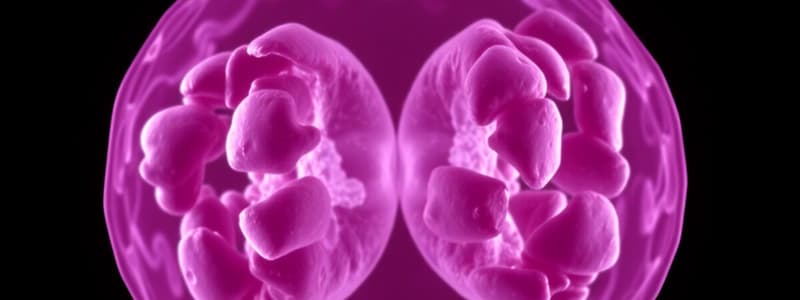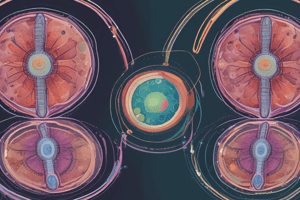Podcast
Questions and Answers
What is the main purpose of mitosis in multicellular organisms?
What is the main purpose of mitosis in multicellular organisms?
- To produce identical daughter cells for growth and repair (correct)
- To produce gametes for reproduction
- To create haploid cells for fertilization
- To increase genetic diversity
Which process is responsible for increasing genetic diversity during sexual reproduction?
Which process is responsible for increasing genetic diversity during sexual reproduction?
- Binary fission
- Mitosis
- Meiosis (correct)
- Asexual reproduction
What characterizes a key difference between mitosis and meiosis?
What characterizes a key difference between mitosis and meiosis?
- Mitosis only occurs in prokaryotes
- Mitosis involves genetic recombination
- Meiosis results in diploid cells
- Mitosis produces two identical cells, while meiosis produces four genetically diverse cells (correct)
In mitosis, what happens to the genetic information during cell division?
In mitosis, what happens to the genetic information during cell division?
Which role of meiosis contributes to the survival of species?
Which role of meiosis contributes to the survival of species?
How does crossing over during meiosis contribute to genetic diversity?
How does crossing over during meiosis contribute to genetic diversity?
Which statement accurately reflects how mitosis indirectly contributes to the survival of species?
Which statement accurately reflects how mitosis indirectly contributes to the survival of species?
What type of cells does meiosis produce?
What type of cells does meiosis produce?
What enzyme is responsible for breaking the hydrogen bonds between DNA bases during replication?
What enzyme is responsible for breaking the hydrogen bonds between DNA bases during replication?
In semi-conservative DNA replication, what is true about the strands produced?
In semi-conservative DNA replication, what is true about the strands produced?
What role does DNA polymerase play in DNA replication?
What role does DNA polymerase play in DNA replication?
What structure forms as DNA polymerase stitches together newly joined nucleotides?
What structure forms as DNA polymerase stitches together newly joined nucleotides?
What is the first step in the process of DNA replication?
What is the first step in the process of DNA replication?
Flashcards
Mitosis
Mitosis
A type of cell division that produces two identical daughter cells from a single parent cell.
Meiosis
Meiosis
A type of cell division that produces haploid gametes (sperm and egg) with half the number of chromosomes.
what does the Continuity of species mean
what does the Continuity of species mean
The continuation of a species through reproduction and the passing of genetic information.
Growth (in cells)
Growth (in cells)
Signup and view all the flashcards
Repair (in cells)
Repair (in cells)
Signup and view all the flashcards
what does Genetic variation mean
what does Genetic variation mean
Signup and view all the flashcards
Haploid gametes
Haploid gametes
Signup and view all the flashcards
Assess
Assess
Signup and view all the flashcards
DNA Structure
DNA Structure
Signup and view all the flashcards
DNA Helicase
DNA Helicase
Signup and view all the flashcards
Template Strands
Template Strands
Signup and view all the flashcards
Semi-Conservative Replication
Semi-Conservative Replication
Signup and view all the flashcards
DNA Polymerase
DNA Polymerase
Signup and view all the flashcards
Study Notes
Cell Division Processes for Species Continuity
- Mitosis and meiosis are crucial for species continuity, enabling growth, repair, reproduction, and genetic variation.
Mitosis: Growth and Repair
- Process: Mitosis produces two identical daughter cells from one parent cell.
- Importance in organisms: Essential for growth and repair of tissues in multicellular organisms.
- Example: Repairing damaged skin cells.
- Genetic implications: Ensures each new cell has the same genetic material as the original, preventing diseases like cancer.
- Indirect contribution to species survival: By enabling organisms to function properly.
Meiosis: Sexual Reproduction and Genetic Diversity
- Process: Creates haploid gametes (sperm and eggs) with half the number of chromosomes as other cells.
- Crucial for: Sexual reproduction.
- Genetic variation: Achieved through crossing over (DNA exchange between homologous chromosomes) and independent assortment (random chromosome distribution in gametes).
- Importance in adaptation: Genetic diversity allows populations to adapt to environmental changes, like climate shifts, thus supporting species survival.
- Ensuring correct chromosome number in zygote: Meiosis ensures the correct chromosome count when fertilization occurs.
Combined Roles
- Mitosis and meiosis work synergistically: Mitosis maintains the individual, while meiosis creates diversity for future generations, making species sustainable and adaptable.
- Essential Function: These processes are crucial for species to maintain stable populations and to evolve over time.
Studying That Suits You
Use AI to generate personalized quizzes and flashcards to suit your learning preferences.
Description
Explore the essential processes of mitosis and meiosis that ensure species continuity. Understand how mitosis contributes to growth and repair, while meiosis is vital for sexual reproduction and genetic diversity. This quiz will test your knowledge on these crucial cellular processes.



